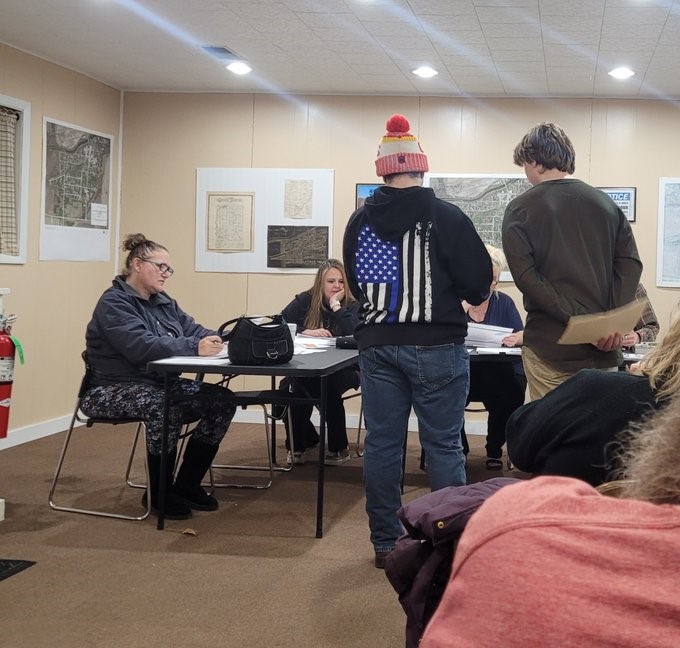Taking Action: Participatory Government through Service Learning

Taking informed action through service learning results in increased civic knowledge as well as the development of skills and dispositions related to active citizenship. This proven practice helps to facilitate a deeper understanding of the roles and responsibilities necessary to contribute to the common good through student-centered experiential learning.
The Pedagogy Companion to the Educating for American Democracy Report published in 2021 further explains the importance of constitutional democracy as content AND practice:
Classroom-based practices of constitutional democracy are a pedagogical approach that centers the student in the instructional activity and cultivates the daily habits of a learner and citizen. Such repeated, even daily processes allow students to master the content and concepts of American constitutional democracy by regularly engaging in its practice. When done well, direct engagement encourages student-teacher contact, student collaboration, and active learning and reflection (pg. 12)
Jennifer Burdette, a social studies teacher at Spoon River Valley Junior/Senior High School in western Illinois, facilitates all 8th-grade students to take informed action as the capstone of the “Taking Action: Participatory Government through Service Learning” class they created this year. We asked Jen to share a bit more about her experience of teaching this new class with the goal of helping our youngest citizens understand their role as civic participants. Here are her responses.
Can you tell us a bit more about this new course?
This class asked students to examine the purpose of government, different types of governments, and the principles of democracy. Then students looked at ways citizens participate in democracy and social movements that impacted change. The final part of our whole class study asked students to evaluate what type of citizen they wanted to be and the qualities that make good leaders. The second half of the quarter was then built around students developing their own service learning projects. We used the Mikva Soapbox Curriculum to examine issues in our community, and students gave speeches to the class about an issue of their choosing. Once all speeches were given, the students were given the option to choose a project they wanted to take action on. Sometimes students chose to come together and collaborate on one topic. Other students continued on their projects independently.
What are some of the examples of the issues and projects that students engaged in?
Sample projects that came out of this class included: trying to update the basketball courts in one of our communities, working to change a dress code policy, proposing tree planting to our high school science club, working towards a community center, addressing issues related to school water and the gym, proposing a snack time to combat hunger, a student incentive day, and anti-bullying initiatives. All students were asked to research their topic, collect data through surveys, analyze the data and then create a presentation or letter to a stakeholder. Students were then asked to reflect on the experience and evaluate how it impacted their view of what type of citizen they wanted to be.
In particular two students decided to focus on their community basketball court in London Mills and work to get the courts improved. The students collected photographic evidence of the issues with the basketball court, surveyed residents of the town on their view of the issue through social media, and compiled their data into a presentation. The students contacted the town board and were placed on the agenda for February. At the meeting, the students presented their findings and received affirmation from the community that they would receive new hoops and begin investigating a solution for the court.
How did this activity deepen students’ disciplinary content knowledge and/or meet learning targets?
Initially, students were asked to learn about these principles represented in our government and examine how others have gone about the process of affecting change in the world. However, this took on a deeper level of understanding once students went through the process themselves. Students were proud of the work they did and felt like their voices were heard. Additionally, it positively impacted their view of citizenship in the sense that after the project many students said they wanted to become participatory or justice-oriented citizens.
How did this project deepen students’ knowledge of themselves and their community?
Students were asked to examine their communities and how they could see themselves improving their communities. In creating the arguments for their project, students had to analyze their own views of why they were doing the project and justify how their communities would benefit from it in order to convince stakeholders.
What comes next? What did students identify as future opportunities for civic engagement?
I believe this was an eye-opener for students that no matter your age you can work to make a difference if you try. Unfortunately, I don’t have these students again until sophomore year, but I can’t wait to see what they do in high school after having this experience in junior high.
One student who worked on the basketball court project shared, “I thought it was cool because I felt like I was important for one time and because it felt official being at the meeting.” The other reflected, “I felt happy to make our courts better because it is something I can practice on and help me improve my basketball skills.”
What advice would you give teachers thinking about opportunities for engaging their students in service learning?
The idea of having multiple students conducting different projects at the same time can seem overwhelming but it is POSSIBLE and the experience is so rewarding for students. Using a planning sheet, check-in documents, and requiring similar steps of the students helped make the project manageable even when they were going in different directions.
